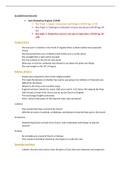ELIZABETHAN ENGLAND
Early Elizabethan England 1558-88
Key Topic 1: Queen, Government and Religion 1558-69 (pg. 16-30)
Key Topic 2: Challenges to Elizabeth at home and abroad 1569-88 (pg. 48-
60)
Key topic 3: Elizabethan society in the age of exploration 1558-88 (pg. 80-
108)
Margaret Ward
- She was born in Cheshire in the North of England where Catholic beliefs were especially
strong
- She discovered there was a Catholic priest locked up in a nearby prison
- She smuggled him a rope and he escaped
- She was arrested as she was his only visitor
- When put on trial she confessed and refused to say where the priest was hiding
- She was hanged on the 30th of August
Religious divisions
- People were prepared to die for their religious beliefs
- This made the decision of whether the country was going to be Catholic or Protestant very
difficult for the Queen
- Whatever she chose some would be angry
- England had been Catholic for nearly 1000 years until in 1533 Henry VIII replaced the Pope
with himself as head of the church and set up the Church of England
- This encouraged English protestants
- Mary I restored the power of the Pope but many were protestant
Catholics
- They wanted the Pope as head of the Church
- With the structure of cardinals, archbishops and bishops to help the Pope govern the church
Protestants
- Wanted King/Queen as head of the Church, with archbishops and bishops to help the
monarch
Puritans
- Do not believe in a Head of Church or bishops
- They wanted committees elected by churchgoers to make the rules
Decoration and Music
- Catholic churches were built to show the glory of God, they were elaborate and exspensive.
, - These churches often had glass stain windows, statues, pictures and murals, wood and
marble carvings, with huge organs and altars
- Many left money to the church when they died for church decorations
- Protestants saw this as against the teachings of Jesus
- When Edward VI made the country Protestant all the decorations were removed but most
were just hidden and brought back out for Mary’s reign
The clergy
- In 1558 at the end of Mary’s reign all the clergy were Catholic
- If Elizabeth wanted the religion to be Protestant she would have to replace all the clergy
with qualified protestants or convince them to change their religion
- Under Edward’s Protestant Reformation the clergy were able to get married, but when Mary
took charge many had to choose between their wives or jobs
- Catholics preferred richly decorated robes called vestments
- Puritans liked plain black gowns
- Protestants wanted something in between
Bible and Church service
- After Mary’s reign the church services were Catholic and in Latin
- Edward VI introduced two protestant books of common prayer which had the services in
English, these were overturned by Mary. Elizabeth had to choose
Catholics
- Wanted the bible in Latin, read only by priests, and church services with the Latin Mass
- believed that a miracle took place during mass during the Eucharist
Protestants
- Wanted the bible in English, which everyone could read and church services in English with
Holy communion
- They believed the bread and wine in the Communion service remained bread and wine, but
were also the body and blood of Christ
Puritans
- Wanted the bible in English which everyone could read and church services in English with
communion
- They believed the bread and wine stayed bread and wine and that Jesus was spiritually, not
physically present
Elizabeth’s problems
- Should she change the church to Protestantism? What penalties for people not attending
church? What would be the reaction, would people rebel or try over throw her?
- She needed to try reduce poverty and enforce the law fairly, because if harvests or wars
went badly she would be responsible, rebellion possible.
, - Who would she choose for the Privy council? What would their religion be?
- She had no clear heir, they might be a civil war for power once she died
- The two most powerful countries in Europe were Catholic, Elizabeth was at war with France
which had gone badly. France was allied with Scotland and could invade. Defending the
country was the monarchs most important duty if she failed she could be disposed.
- Most thought a woman was too weak to lead and wanted her to Marry.
- Catholics questioned her right to the throne as she was illegitimate.
Who was Elizabeth?
- Elizabeth’s mother was Anne Boleyn, beheaded for treason in 1536. Elizabeth was declared
illegitimate and lost her right to the throne. Henry’s new wife jane Seymour gave birth to
Edward.
- Elizabeth was brought up Protestant and learned Greek, Latin, French and Italian. She was
taught bible stories, dancing, riding, archery, and needlework and was fond of music.
Society
Choosing the Privy council
- The Privy council contained Men chosen as advisers and heads of government departments.
They all met frequently, they advise in big decisions, like war, religion, and marriage.
- It was responsible for overseeing finances, meeting foreign ambassadors, drafting
correspondence, and controlling the business of Parliament.
- Made William Cecil her Secretary of State. She appointed the rest of her council quickly.
Thanked last councillors hoping to keep their support.
- Elizabeth did not make her closest friend Robert Dudley councillor for another four years to
avoid jealousies.
- She was careful not to offend powerful men, kept powerful nobles with experience and then
chose trusted colleagues or relatives.
- Elizabeth inherited a debt of £300,000. She cut back on government spending, and
monitored the costs of her household. Exchequer officials had to balance the accounts and





